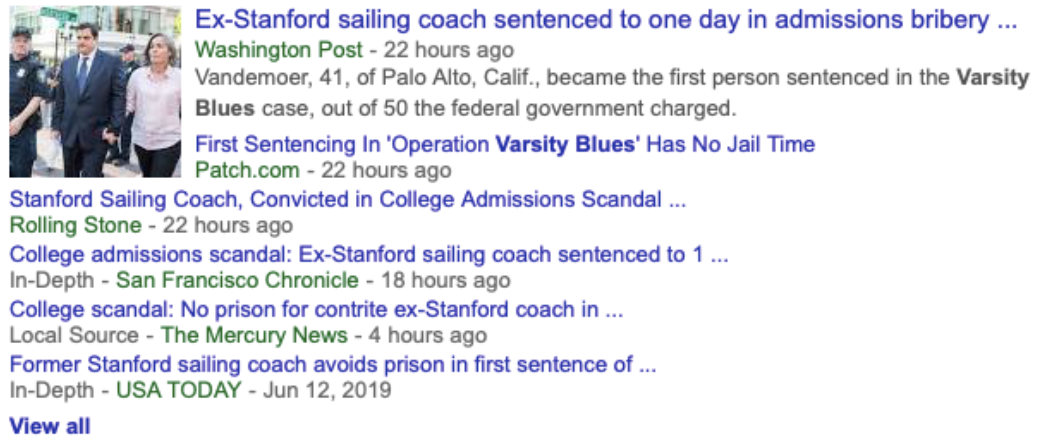On Wednesday, former Stanford sailing coach John Vandemoer was sentenced to one day in prison and six months of home confinement for his role in the recent college admissions scandal. Judging by the headlines, there is outrage in America over this “slap on the wrist.” “Stanford Coach Avoids Prison in Admissions Scandal,” announced The New York Times. Other papers, from both the right and the left, carried similar sounding titles. Finally, bipartisan agreement.
Just to recap, on March 12, 2019, it was revealed that Vandemoer, along with more than 50 others including celebrities such as Felicity Huffman, were found to be involved in a scandal called “Operation Varsity Blues.” Essentially, parents paid over $25 million to the scheme’s head, William Singer, who bribed coaches like Vandemoer to secure athletic spots at top universities for children who were not real athletes. Vandemoer is guilty of accepting a bribe of $610,000. He was the first to be tried from the group.
When you get into Stanford, you are told that you deserve to be here. But in the majority of cases, the truth is not so simple. It is more accurate to say that you were lucky to be born into the right family from the right socioeconomic background which enabled you to attend good schools, hire tutors, etc. Research has shown that, in the past decades, there is a growing correlation between parental income and SAT scores.
But there is a certain tendency for the elites in America to be in denial about the fact that they are elites. “America is a classless society” goes the narrative. You get ahead through perseverance and hard work. America, in the conventional wisdom, is a meritocracy.
Charles Murray’s delves into this in Coming Apart: The State of White America, 1960-2010 (2013). Since he doesn’t believe elites will be able to identify themselves honestly, he provides a quiz about the kind of experiences and cultural products you have consumed over your life which will give you a score of your “eliteness.” The lower the score the more elite. Needless to say, when some of my Stanford peers took it in a class this year, we got very low scores.
Given this reality, the outrage over the current admissions scandal seems feigned. Instead of the classic form of admissions bribery such as donating a building, this scheme was more creative (photoshopping the heads of the students onto pictures of real athletes) and involved celebrities to boot. It was colorful and drew attention.
But the dissatisfaction with the sentence is revealing. How much time would Vandemoer have to do for it to be considered “justice”?
There is an eerie show trial aspect to the recent court verdict of Vandemoer. In the 1930s, Stalin organized show trials to get rid of his enemies for imaginary crimes against the Party. One of the mysteries was why the accused admitted to the crimes. Was it due to torture? It later came to be understood that the accused admitted to their crimes because they were true believers. By telling the truth and admitting that they were innocent, they would be rejecting the party and everything it stood for. It was their last duty as loyal party members. This interpretation was made famous in books such as Arthur Koestler’s Darkness at Noon.
I am not suggesting that the Vandemoer trial compares in any way to the violence of the show trials which happened under a totalitarian regime. I am only trying to suggest one similarity – Vandemoer appears to be a true believer in the meritocratic higher education system. “I deserve all of this — I caused it — and for that I’m deeply ashamed,” he said in an apology statement. But it is questionable whether he is really “guilty” of a horrendous crime. According to U.S. District Judge Zobel, Vandemoer was “probably the least culpable” of the 50 or so charged with the Varsity Blues scandal. This is because he didn’t even pocket the bribe money – he put it into his sailing program instead to buy uniforms and sports gear. In addition, most of the students never ended up attending Stanford.
But his very actions have offended the idea of a meritocratic American society. He has undermined the holy of holies of the American imagination. And for this he must be punished.
Stanford has accordingly gone into damage-control mode. It fired the untouchable the same day he was indicted. It is running an external review of the admissions process. Even the ill-conceived money must be rid of immediately. Stanford plans to donate it to a worthy cause yet to be determined. It must purge itself in order to ensure the purity of its meritocratic admissions process.
I just finished watching the new mini-series Chernobyl about the infamous nuclear disaster and the Soviet union’s attempt to hide from the world the extent of the disaster. In the final episode of the series, the brave scientist Valery Legasov, confronts the lies of the Soviet Union at a show trial and reveals the structural problems of nuclear reactors in the communist state. This comes at a high personal cost; he loses his job and two years later he takes his own life. As a result of his death, the Soviet scientific community could no longer ignore the truth. At the end they fixed the reactors.
What would an equivalent “truth telling” moment look like at Vandemoer’s trial? Just like the scientists in Chernobyl, he knows that he bears part of the blame. However, the bribes took place inside an extremely unmeritocratic system in which many of the wealthy have bribed their way into admissions.
What would he have to say to wake Americans up? Would we even be able to recognize such a moment if we saw it?
Contact Anat Peled at anatpel ‘at’ stanford.edu.
